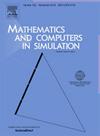Complex dynamics of an SIHR epidemic model with variable hospitalization rate depending on unoccupied hospital beds
IF 4.4
2区 数学
Q1 COMPUTER SCIENCE, INTERDISCIPLINARY APPLICATIONS
引用次数: 0
Abstract
In this paper, we propose an susceptible–infectious–hospitalized–recovered (SIHR) epidemic model with a nonlinear hospitalization rate depending on the number of unoccupied hospital beds. Note that the number of all hospital beds is used as a measure of all available medical resources. The basic reproduction number is calculated using the next-generation matrix method. We analyze the existence of endemic equilibria and discuss the global stability of the disease-free equilibrium. Existence and stability of endemic equilibria indicate possible occurrences of bifurcations. We confirm the appearance of backward bifurcation, saddle–node bifurcation, Hopf bifurcation, and Bogdanov–Takens bifurcation using normal form theory and central manifold theory. Numerical simulations show that the dynamic behavior of the model undergoes a transition from forward bifurcation to backward bifurcation and saddle–node bifurcation when the number of total hospital beds is reduced. Our findings suggest that when the number of total hospital beds falls below a threshold, backward bifurcation will occur, meaning that the disease cannot be eliminated even if the basic reproduction number is below unity. Therefore, the number of hospital beds should be increased beyond the bed threshold during an outbreak of a disease, which has important implications for disease control.
具有可变住院率的 SIHR 流行病模型的复杂动态取决于未占用的医院床位
在本文中,我们提出了一个易感-感染-住院-康复(SIHR)流行病模型,该模型的住院率与闲置病床数量有关,是一个非线性模型。需要注意的是,所有病床的数量是衡量所有可用医疗资源的指标。基本繁殖数采用新一代矩阵法计算。我们分析了地方病均衡的存在性,并讨论了无病均衡的全局稳定性。地方性均衡的存在和稳定性表明可能出现分岔。我们利用正态理论和中心流形理论证实了后向分岔、鞍节点分岔、霍普夫分岔和波格丹诺夫-塔肯斯分岔的出现。数值模拟表明,当病床总数减少时,模型的动态行为会从正向分岔过渡到反向分岔和鞍节点分岔。我们的研究结果表明,当病床总数低于临界值时,将出现向后分叉,这意味着即使基本繁殖数低于 1,也无法消除疾病。因此,在疾病爆发期间,医院床位数应增加到床位临界值以上,这对疾病控制具有重要意义。
本文章由计算机程序翻译,如有差异,请以英文原文为准。
求助全文
约1分钟内获得全文
求助全文
来源期刊

Mathematics and Computers in Simulation
数学-计算机:跨学科应用
CiteScore
8.90
自引率
4.30%
发文量
335
审稿时长
54 days
期刊介绍:
The aim of the journal is to provide an international forum for the dissemination of up-to-date information in the fields of the mathematics and computers, in particular (but not exclusively) as they apply to the dynamics of systems, their simulation and scientific computation in general. Published material ranges from short, concise research papers to more general tutorial articles.
Mathematics and Computers in Simulation, published monthly, is the official organ of IMACS, the International Association for Mathematics and Computers in Simulation (Formerly AICA). This Association, founded in 1955 and legally incorporated in 1956 is a member of FIACC (the Five International Associations Coordinating Committee), together with IFIP, IFAV, IFORS and IMEKO.
Topics covered by the journal include mathematical tools in:
•The foundations of systems modelling
•Numerical analysis and the development of algorithms for simulation
They also include considerations about computer hardware for simulation and about special software and compilers.
The journal also publishes articles concerned with specific applications of modelling and simulation in science and engineering, with relevant applied mathematics, the general philosophy of systems simulation, and their impact on disciplinary and interdisciplinary research.
The journal includes a Book Review section -- and a "News on IMACS" section that contains a Calendar of future Conferences/Events and other information about the Association.
 求助内容:
求助内容: 应助结果提醒方式:
应助结果提醒方式:


